
|
|
|
Hindu Mythology
AIRAVATA - APSARA - BHOOT - BRAHMARAKSHASA - CHAKORA - DAWON - GANDABERUNDA - GANDHARVA - GARUDA - HAMSA - IRAVATI - JARITA - JATAYU - JINNALALUO - KABANDHA - KAMADHENU - LANKINI - MAKARA - MAYURA - NAGA - NANDI - NAVAGUNJARA - PISHACHA - PRETA - RAKSHASA - RAINBOW FISH - ROMPO - SARAMA - SHARABHA - SUPRATIKA - THANACTH - TIMINGILA - TUMBURU - UCHCHAIHSHRAVAS - VANARA - VETALA - YAKSHA - YAKSHINI - YALI
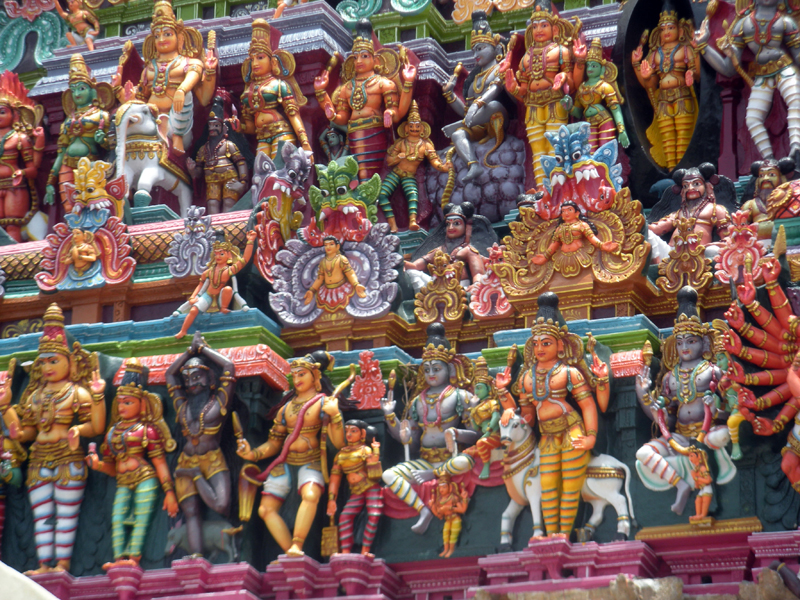
AIRAVATA
Airavata is a mythological white elephant who carries the Hindu god Indra. It is
also called 'abhra-Matanga', meaning "elephant of the clouds"; 'Naga-malla',
meaning "the fighting elephant"; and 'Arkasodara', meaning "brother of the sun".
'Abhramu' is the elephant wife of Airavata. Airavata has ten tusks and five
trunks and is spotless white. It is also known as Erawan in Thai. Airavata is
also the third son of Kashyap and Kadru. In the Mahabharata he is listed as a
great serpent.
According to the Ramayana, the elephant's mother was Iravati. According to the
Matangalila, Airavata was born when Brahma sang sacred hymns over the halves of
the egg shell from which Garuda hatched, followed by seven more male and eight
female elephants. Prithu made Airavata king of all elephants. One of his names
means "the one who knits or binds the clouds" since myth has it that these
elephants are capable of producing clouds. The connection of elephants with
water and rain is emphasized in the mythology of Indra, who rides the elephant
Airavata when he defeats Vritra. This mighty elephant reaches down his trunk
into the watery underworld, sucks up its water, and then sprays it into the
clouds, which Indra then causes to rain forth cool water, thereby linking the
waters of the sky with those of the underworld.
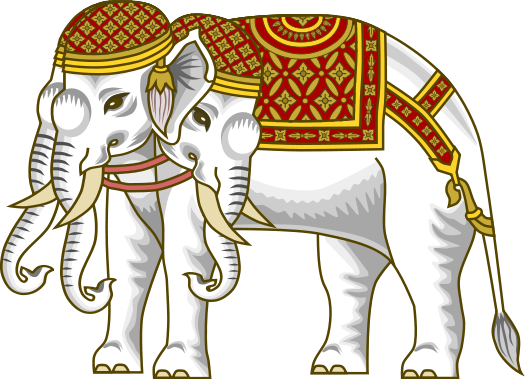
APSARA
An Apsara (also spelled as Apsarasa) is a female spirit of the clouds and waters
in Hindu and Buddhist mythology.
In Indian mythology, Apsaras are beautiful, supernatural female beings. They are
youthful and elegant, and superb in the art of dancing. They are often wives of
the Gandharvas, the court musicians of Indra. They dance to the music made by
the Gandharvas, usually in the palaces of the gods, entertain and sometimes
seduce gods and men. As ethereal beings who inhabit the skies, and are often
depicted taking flight, or at service of a god, they may be compared to angels.
Apsaras are said to be able to change their shape at will, and rule over the
fortunes of gaming and gambling. Urvasi, Menaka, Rambha, Tilottama and Ghritachi
are the most famous among them. Apsaras are sometimes compared to the muses of
ancient Greece, with each of the 26 Apsaras at Indra's court representing a
distinct aspect of the performing arts. They are associated with fertility
rites.
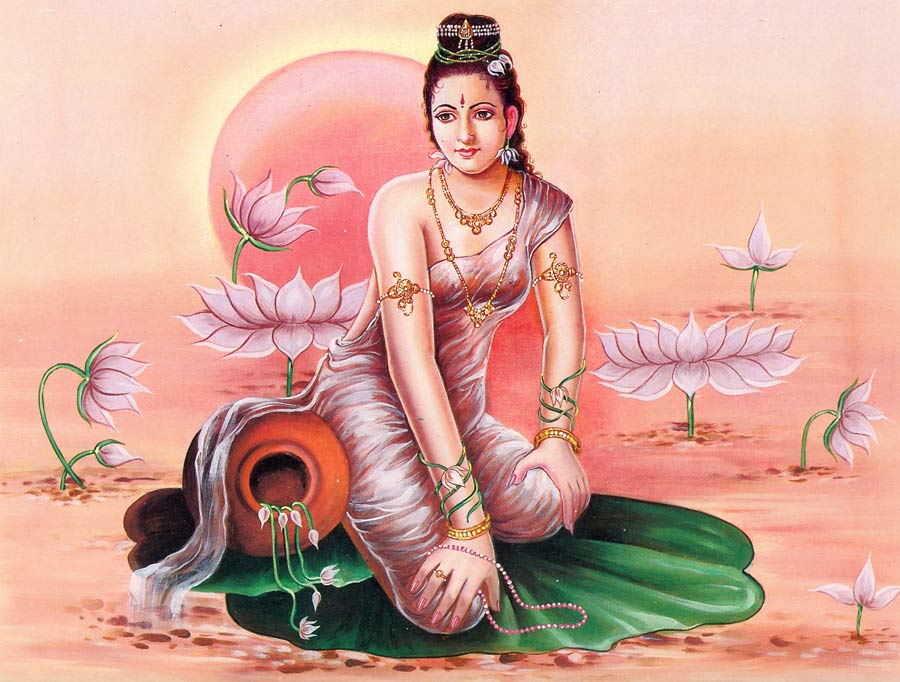
BHOOT
A bhoot or bhut is a supernatural creature, usually the ghost of a deceased
person, in the popular culture, literature and some ancient texts of the Indian
subcontinent. Interpretations of how bhoots come into existence vary by region
and community, but they are usually considered to be perturbed and restless due
to some factor that prevents them from moving on (to transmigration, non-being,
nirvana, or heaven or hell, depending on tradition). This could be a violent
death, unsettled matters in their lives, or simply the failure of their
survivors to perform proper funerals.
The belief in ghosts is deeply ingrained in the minds of the people of India
across generations and it still persists even in an era of modern technology and
scientific development. The various concepts of ghosts trace their roots in the
vast bodies of Hindu mythology, religious texts, literature and folktales. There
are many allegedly haunted places in India, such as dilapidated buildings, royal
mansions, forts, forest bungalows, burning ghats etc. Ghosts also occupy a
significant place in the Bengali culture. Ghosts and various supernatural
entities form an integral part of the socio-cultural beliefs of the both Hindu
and Muslim communities of rural Bengal. Fairy tales often use the concept of
ghost and references to paranormal activities are found amply in modern-day
Bengali literature, cinema, radio and TV programmes.

BRAHMARAKSHASA
Brahmarakshasas (Sanskrit:
ब्रह्मराक्षस)
are fierce demon spirits in Hindu mythology.
Brahm Rakshas is actually the spirit of a Brahmin, a dead scholar of high birth,
who has done evil things in his life or has misused his knowledge, who has to
suffer as a Brahm Rakshas after his or her death. The earth-bound duties of such
a scholar would be to disappear or impart knowledge to good students. If he did
not do so, he would turn into a Brahma Rakshas after death which is a very
fierce demonic spirit. The word Brahm means Brahmin and Rakshas, a demon. As per
ancient Hindu texts they are powerful demon spirit, who have lot of powers and
only few in this world can fight and over-come them or give them salvation from
this form of life. It would still retain its high level of learning. But it
would eat human beings. They have the knowledge of their past lives and vedas
and puranas. In other words they have qualities of both Brahmin and Rakshas.
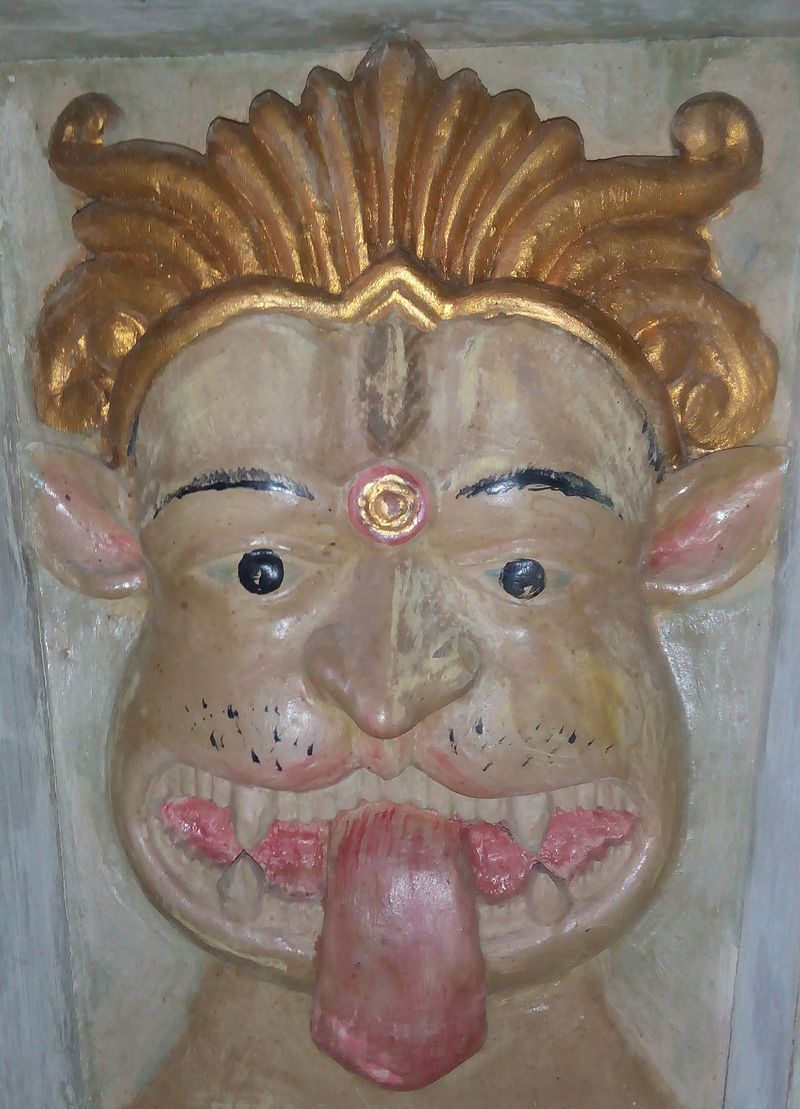
CHAKORA
Height: (M) 1'6 Feet , (F) 1'5 Feet
Wings: (M) 5 Feet , (F) 4'10 Feet
Weight: (M) 5 Pounds , (F) 6 Pounds
Chakora, (Sanskrit:
चकोर) a kind of
partridge, is a legendary bird described in Hindu mythology. It is believed to
reside upon the beams of the moon, that is, the Chandra. The association of
Chakora and Chandra has given rise to a number of folk love stories in north
India.
DAWON
Shoulder-Height: (M) 3'9 Feet , (F) 3'5 Feet
Length: (M) 7 Feet , (F) 6'4 Feet
Weight: (M) 360 Pounds , (F) 290 Pounds
Dawon, a sacred tiger (sometimes drawn as a lion ) originated from Tibetan
legend but was later adapted to Hindu mythology. In the later myth, it was
offered by gods to serve goddess Durga or Parvati as mount for rewarding her
victory. As Durga fought with ten weapons wielded on her arms, Dawon supported
its mistress and attacked the foes with its claws and fangs. Also the
threatening tiger represented power from the wars its mistress had won over all
enemies.
Dawon in traditional and ancient Bengali culture and Indian culture has often
been represented in the Ghatokbahini (Bengali:
ঘটকবাহিনী
সিংহ)
also known as Ghatokbahini Singha form, that is half
lion and half tiger.

GANDABERUNDA
Height: (M) 50 Feet , (F) 46 Feet
Length: (M) 70 Feet , (F) 66 Feet
Wingspan: (M) 100 Feet , (F) 96 Feet
Weight: (M) 17000 Pounds , (F) 16000 Pounds
The bird is generally depicted as clutching elephants in its talons and beaks
demonstrating its immense strength. In a coin (kasu) found in Madurai, it is
shown holding a snake in its beak. All 2-dimensional depictions show a
symmetrical image similar to the Double-headed eagle, other images show the long
tail feathers resembling a peacock which is the national bird of India. In the
Chennakeshava temple of Belur (1113), Karnataka, Gandaberunda (2-faced bird
identified with Vishnu) depiction is a carved scene of "chain of destruction".
Initially, a deer is prey to a large python, followed by being lifted by an
elephant and a lion attacking the elephant, and the lion shown as devoured by
Sharabha. The last scene depicted is of Gandaberunda destroying Sharabha. The
Gandaberunda was a physical form displayed by Narasimha, Man-Lion incarnation of
Vishnu.
After Narasimha had slain demon Hiranyakashipu, through the taste of blood,
Narasimha did not let go of his dreadful form. Demigods were even more afraid of
the supreme lord now, than before of the demon. Shiva, the best friend of
Vishnu, thus shiva incarnated as Veerabhadra, Rudra and kala bhairava and
Narasimha slain all forms of Shiva and thus incarnated himself as Sharabha, a
part-lion and part-bird beast which was the terror of the lion. Gandaberunda,
having two heads, fearful rows of teeth, black in complexion and with wide
blazing wings fought with Shiva-Sharabha for eighteen days and finally held it
between his two beaks and killed Sharabha but also exploded and got killed in
the process.
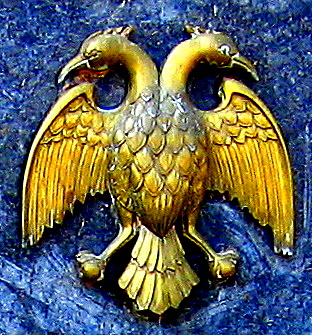
GANDHARVA
Gandharva is a name used for distinct heavenly beings in Hinduism and Buddhism;
it is also a term for skilled singers in Indian classical music.
In Hinduism, the Gandharvas (Sanskrit:
गन्धर्व,
gandharva, Assamese:
গন্ধৰ্ব্ব
gandharbba, Kannada:
ಗಂಧರ್ವ,
Tamil:
கந்தர்வர், Telugu:
గంధర్వ
gandharvudu, Malayalam:
ഗന്ധർവൻ)
are male nature spirits, husbands of the Apsaras. Some
are part animal, usually a bird or horse. They have superb musical skills. They
guarded the Soma and made beautiful music for the gods in their palaces.
Gandharvas are frequently depicted as singers in the court of Gods.
Gandharvas act as messengers between the gods and humans. In Hindu law, a
Gandharva marriage is one contracted by mutual consent and without formal
rituals.
Gandharvas are mentioned extensively in the epic Mahabharata as associated with
the devas (as dancers and singers) and with the Yakshas, as formidable warriors.
They are mentioned as spread across various territories.
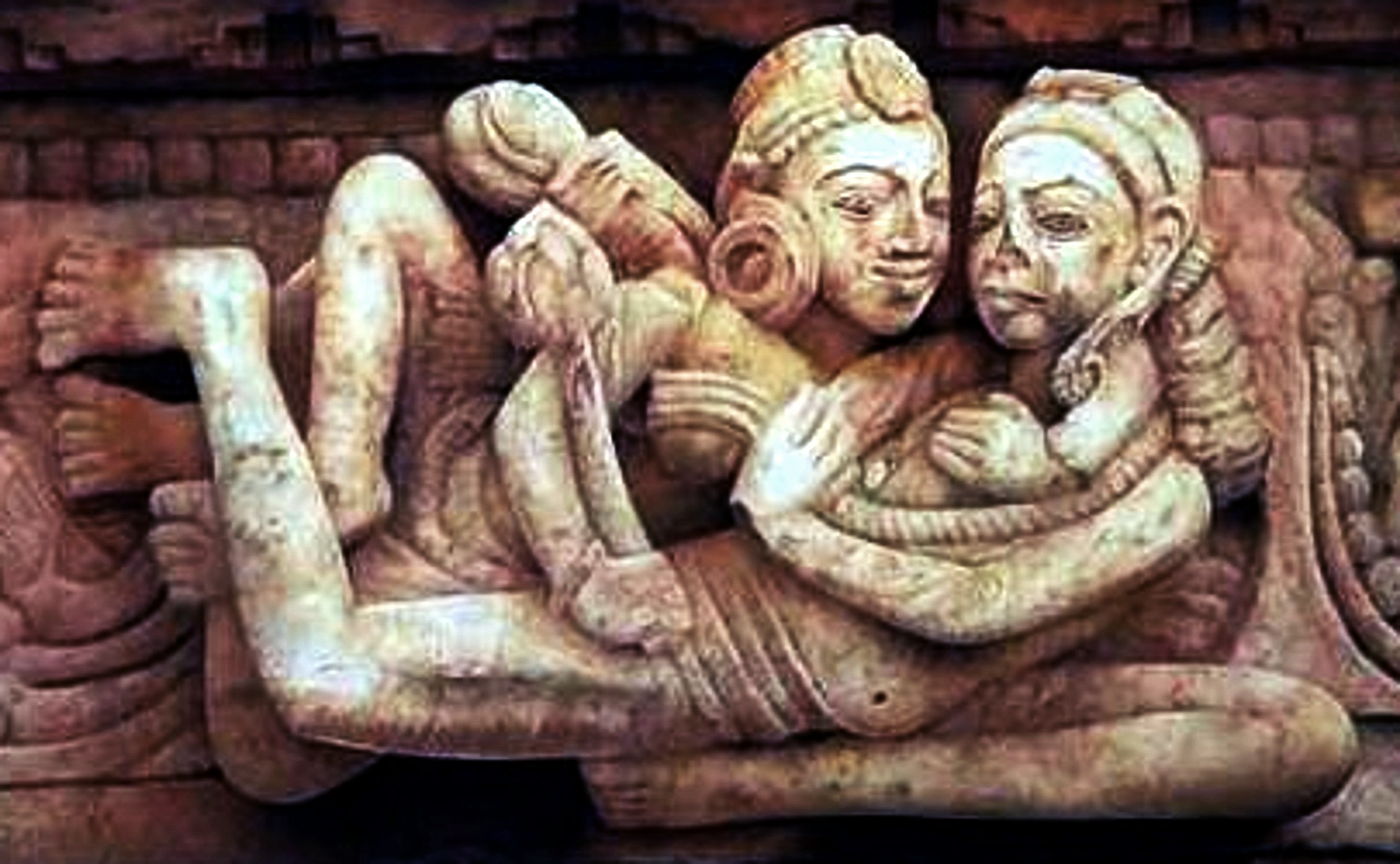
GARUDA
Height: (M) 12 Feet , (F) 11'1 Feet
Wingspan: (M) 30 Feet , (F) 27'3 Feet
Weight: (M) 1200 Pounds , (F) 880 Pounds
Garuda is depicted as having the body of a strong man with a white face, red
wings and eagle’s talons and beak.
The Garuda is a large mythical bird, bird-like creature, or humanoid bird that
appears in both Hindu and Buddhist mythology. Garuda is the mount (vahana) of
the Lord Vishnu. Garuda is the Hindu name for the constellation Aquila. The
brahminy kite and phoenix are considered to be the contemporary representations
of Garuda. Indonesia adopts a more stylistic approach to the Garuda's depiction
as its national symbol, where it depicts a Javanese eagle (being much larger
than a kite).
Garuda is known as the eternal sworn enemy of the Nāga serpent race and known for feeding exclusively on snakes, such behavior may have referred to the actual short-toed eagle of India. The image of Garuda is often used as the charm or amulet to protect the bearer from snake attack and its poison, since the king of birds is an implacable enemy and "devourer of serpent". Garudi Vidya is the mantra against snake poison to remove all kinds of evil.

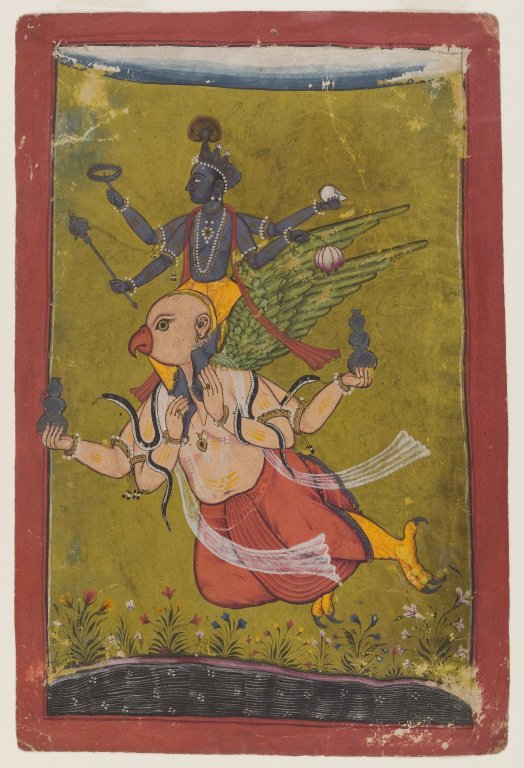
HAMSA
(bird)
The hamsa (Sanskrit:
हंस, haṃsa or hansa) is an aquatic bird of passage,
such as a goose or a swan. Its icon is used in Indian and Southeast Asian
culture as a spiritual symbol and a decorative element.
Monier Williams translates the term from Sanskrit as "goose, gander, swan,
flamingo, or other aquatic bird of passage". The word is also used for a
mythical or poetical bird with knowledge. In the Rig Veda, it is the bird which
is able to separate Soma from water, when mixed; in later Indian literature, the
bird separates milk from water when mixed. In Indian philosophical literature,
Hamsa represents the individual soul or spirit (typified by the pure
sunlight-white like color of a goose or swan), or the "Universal Soul or Supreme
Spirit".
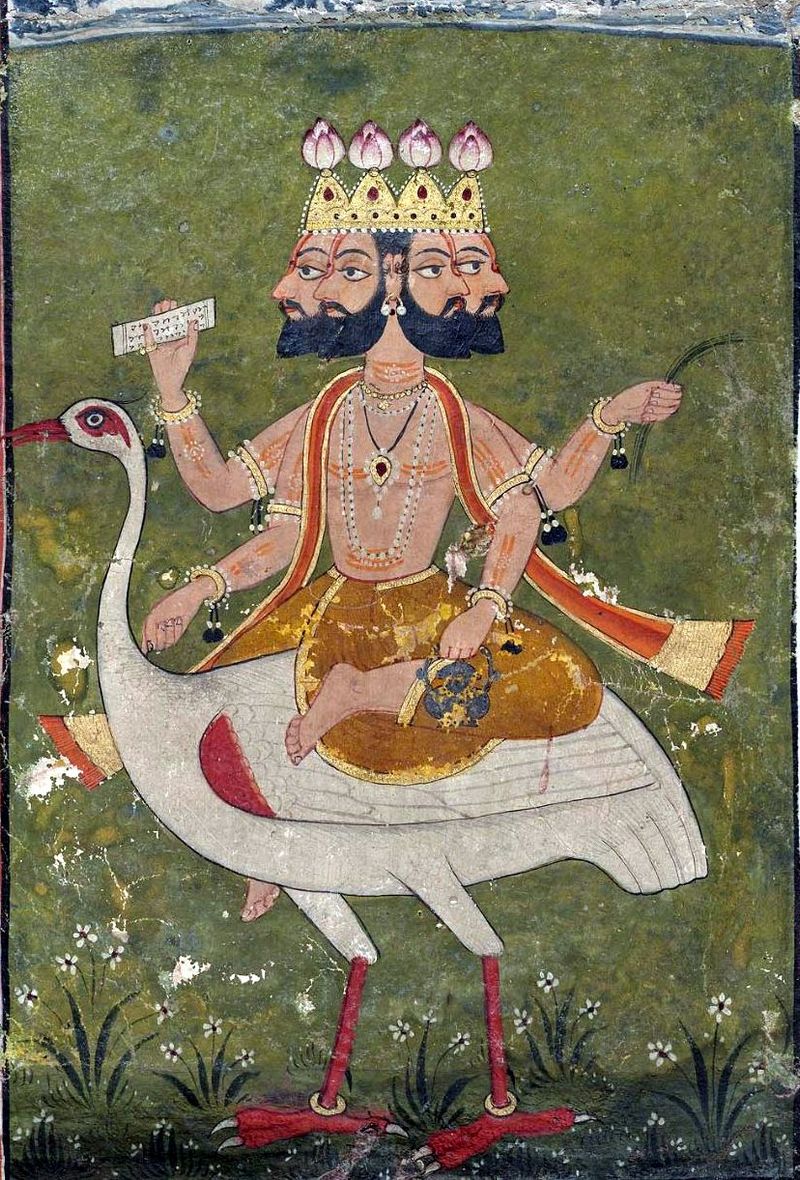
IRAVATI
Height: (M) 5'4 Feet , (F) 5 Feet
Weight: (M) 120 Pounds , (F) 95 Pounds
Human + Chital Horns, Ears, Long-Tail and Feet = Iravati
Iravati (irāvatī) is a daughter of Kadru and Kasyapa. She is the mother of Airavata, the mount of Indra. She is also associated with a sacred river.
JARITA
Jarita (Sanskrit: जरित)
was a certain female bird of the species called
Sarngika, whose story is told in the Mahabharata. The saint Mandapala, who
returned from the shades because he had no son, assumed the form of a male bird,
and by her had four sons. He then abandoned her. In the conflagration of the
Khandava Forest she showed great devotion in the protection of her children, and
they were eventually saved through the influence of Mandapala over the god of
fire. Their names were Jaritari, Sarisrikta, Stambamitra, and Drona. They were
"interpreters of the Vedas" and there are hymns of the Rigveda bearing the names
of the second and the third.
Jatayu (Sanskrit:
जटायुः Jatāyu) is the youngest son of Aruna. His
brother, Sampāti, is a demi-god who has the form of a Vulture and was an old
friend of Dasharatha (Rama's father).
In the Epic Ramayana when Jatayu sees Ravana abducting Sita, he tries to rescue
Sita from Ravana . Jatayu fought valiantly with Ravana, but as he was very old
Ravana soon got the better of him. As Rama and Lakshmana chanced upon the
stricken and dying Jatayu in their search for Sita, he informs them of the fight
between him and Ravana and tells them that he had gone south.
Jatayu and his brother Sampati, when young, used to compete as to who could fly
higher. On one such instance, Jatayu flew so high that he was about to get
seared by the sun's flames. Sampati saved his brother by spreading his own wings
and thus shielding Jatayu from the hot flames. In the process, Sampati himself
got injured and lost his wings. As a result, Sampati lived wingless for the rest
of his life.
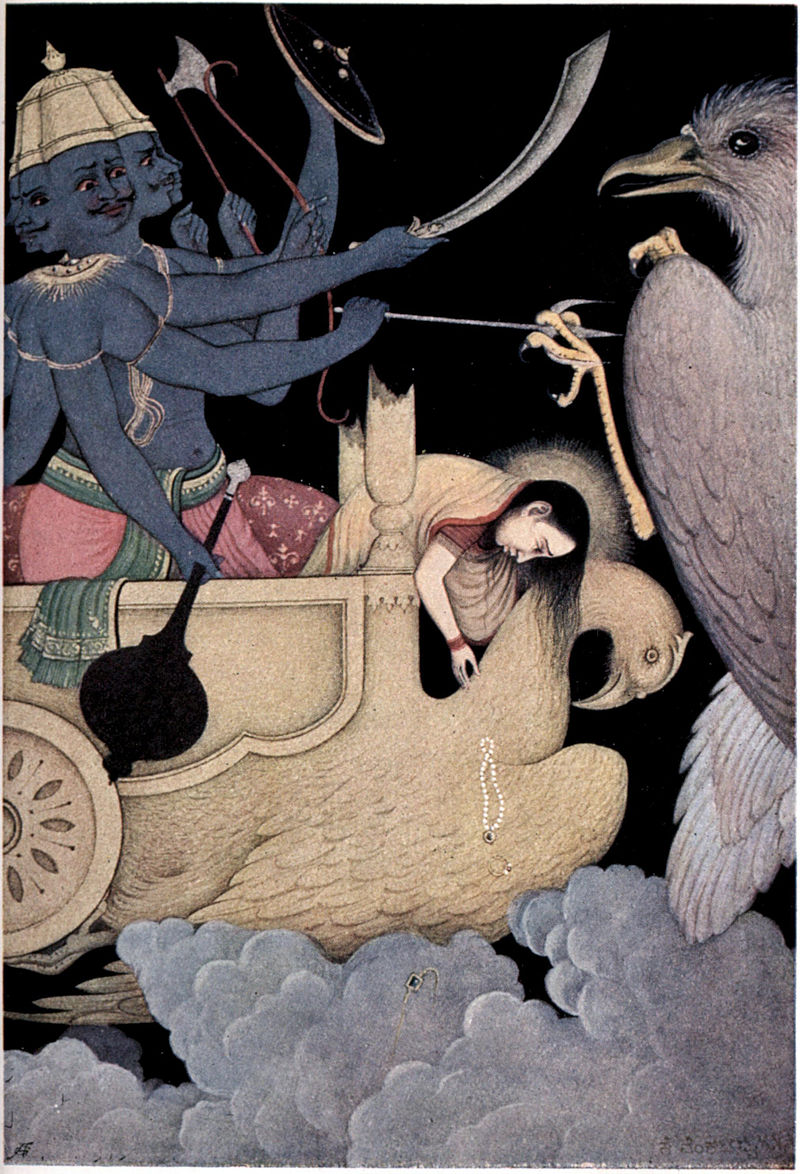
JINNALALUO
The jinnalaluo (also called kimnaras, feiren, and yeishen) were divine creatures
with human bodies and animal's heads that were featured in Buddhist mythology.
These beings resemble human bodies and have the heads of animals, most notably
horses or birds.
They are celestial musicians, whose music is said to fill Heaven. They play a
variety of instruments and are linked to a very ancient Indian art form, where
they are portrayed as birds-of-paradise.
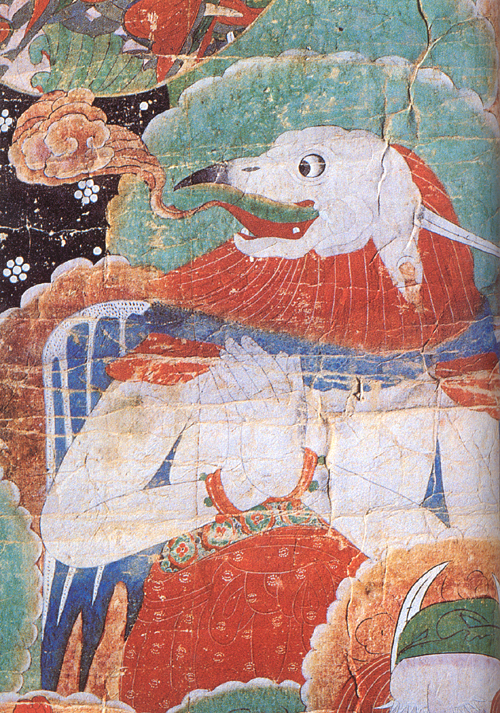
KABANDHA
Height: (M) 20 Feet , (F) 18'5 Feet
Weight: (M) 13000 Pounds , (F) 11900 Pounds
In Hindu mythology, Kabandha (कबन्ध,
Kabandha, lit. "headless torso") is a Rakshasa (demon) who is killed and freed
from a curse by the god Rama – an Avatar of Vishnu – and his brother Lakshmana.
Kabandha's legend appears in the Hindu epics Ramayana and Mahabharata, as well
as in later Ramayana adaptations.
Kabandha was a Gandharva (celestial musician) named Vishvavasu or Danu, who was
cursed and made into an ugly, carnivorous demon by Indra, the king of the gods,
and/or a sage. In an encounter with Rama and Lakshmana, the brothers sever his
arms and proceed to cremate his corpse. Upon his death, Kabandha resumes his
gandharva form and directs Rama to the Rsyamukha mountain, where the exiled
monkey-chief Sugriva is hiding. Kabandha advises Rama to form an alliance with
Sugriva, who would be of assistance in the search for Rama's wife Sita, who had
been kidnapped by Ravana, the demon-king of Lanka. Following Kabandha's
instructions, Rama befriends Sugriva and rescues Sita with his help.
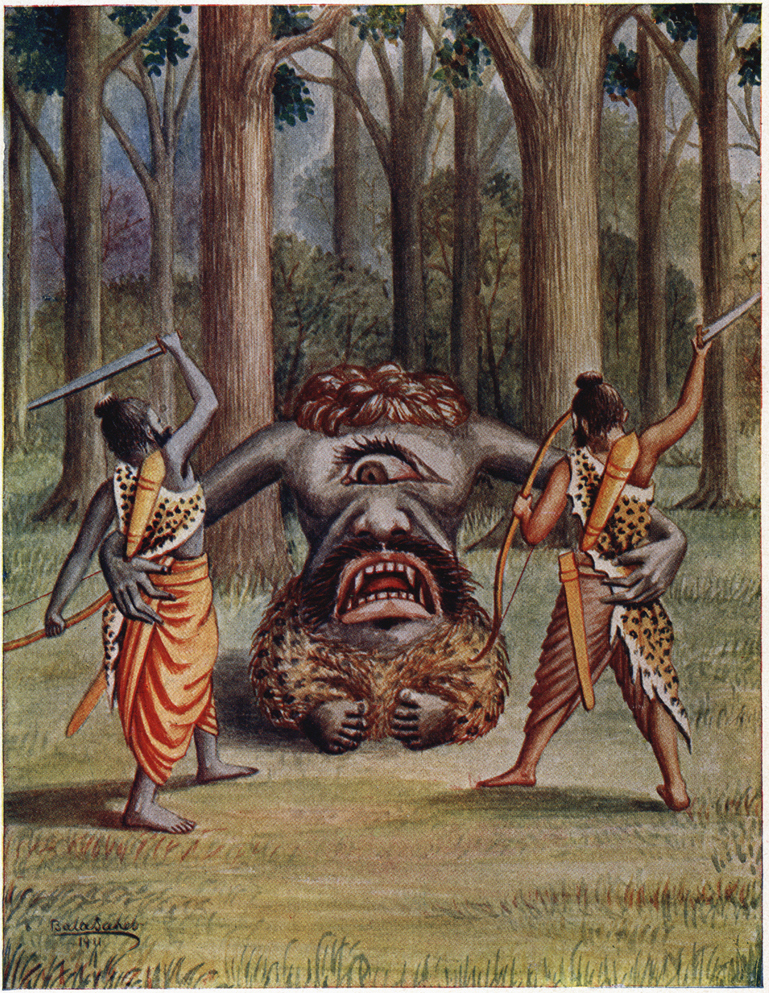
KAMADHENU
Shoulder-Height: (M) 5 Feet , (F) 4'7 Feet
Wingspan: 23 Feet
Weight: 1150 Pounds
Brahman and Tail + Peacock-Tail + Colourful-Eagle-Wings + Human-Headed and
Two-Nipples = Kamadhenu
Kamadhenu (कामधेनु, Kāmadhenu), also known as Surabhi (सुरभि, Surabhī), is a divine bovine-goddess described in Hinduism as the mother of all cows. She is a miraculous "cow of plenty" who provides her owner whatever he desires and is often portrayed as the mother of other cattle as well as the eleven Rudras. In iconography, she is generally depicted as a white cow with a female head and breasts or as a white cow containing various deities within her body. All cows are venerated in Hinduism as the earthly embodiment of the Kamadhenu. As such, Kamadhenu is not worshipped independently as a goddess, and temples are not dedicated to her honor alone; rather, she is honored by the veneration of cows in general throughout the observant Hindu population.
Hindu scriptures provide diverse accounts of the birth of Kamadhenu. While some narrate that she emerged from the churning of the cosmic ocean, others describe her as the daughter of the creator god Daksha, and as the wife of the sage Kashyapa. Still other scriptures narrate that Kamadhenu was in the possession of either Jamadagni or Vashista (both ancient sages), and that kings who tried to steal her from the sage ultimately faced dire consequences for their actions. Kamadhenu plays the important role of providing milk and milk products to be used in her sage-master's oblations; she is also capable of producing fierce warriors to protect him. In addition to dwelling in the sage's hermitage, she is also described as dwelling in Goloka - the realm of the cows - and Patala, the netherworld.
A
cow, identified with Kamadhenu, is often depicted accompanying the god
Dattatreya. In relation to the deity's iconography, she denotes the Brahminical
aspect and Vaishnava connection of the deity contrasting with the accompanying
dogs, symbolizing a non-Brahminical aspect. She also symbolizes the Panch Bhuta
(the five classical elements) in the icon. Dattatreya is sometimes depicted
holding the divine cow in one of his hands.
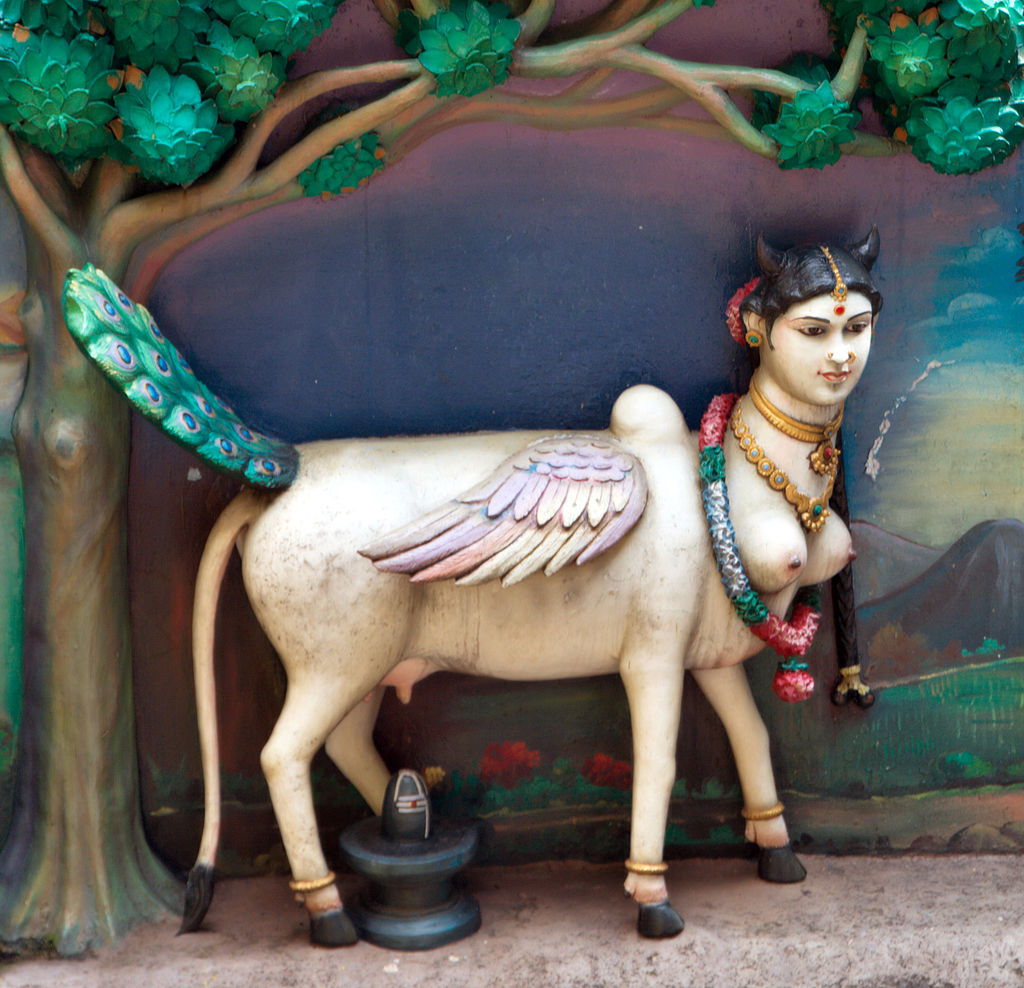
LANKINI
Lankini was a powerful Rakshasa from the ancient Hindu epic Ramayana. Her name
literally means "The Deity of Lanka" as she was the female personification of
the city itself and was the guardian to the doors of Lanka.
As per Indian mythology, Lankini was once the guardian of the abode of Brahma.
As she guarded the home of the creator, Brahma, she became arrogant and egoistic
about her position. She treated others in the palace with contempt due to which
she was cursed by Brahma to guard the city of Rakshasas forever. Lankini
realized her mistake and begged for forgiveness. However it was not possible for
Brahma to take back the curse, and instead gave her a boon she will be freed of
the curse only when a monkey will defeat her in combat and thus bring to end the
age of Rakshasas.
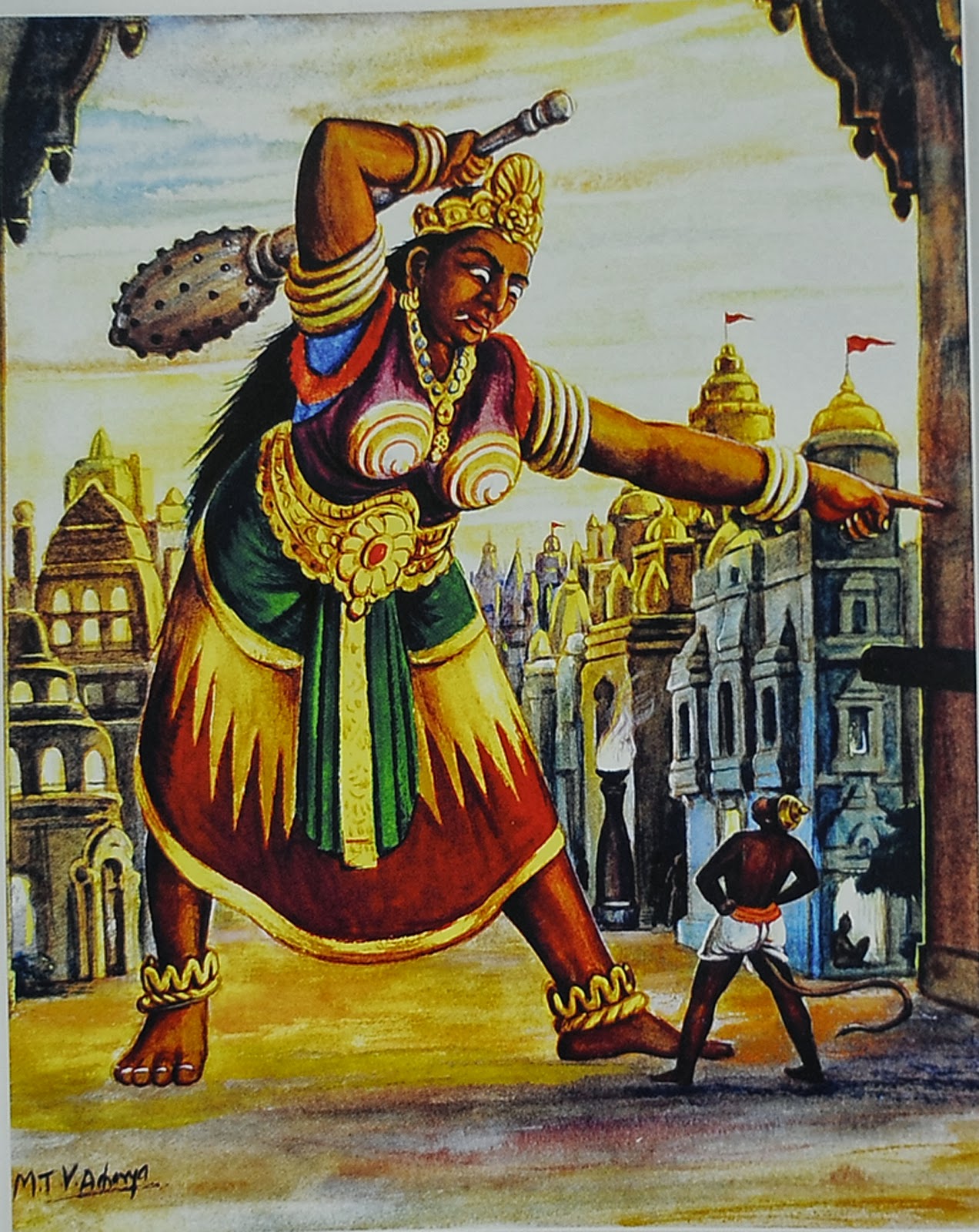
MAKARA
Height: (M) 4'6 Feet , (F) 4'2 Feet
Length: (M) 18 Feet , (F) 17 Feet
Weight: (M) 1100 Pounds , (F) 940 Pounds
Makara (मकर) is a sea-creature in Hindu culture. It is generally depicted as half terrestrial animal in the frontal part (stag, deer, crocodile, or elephant) and half aquatic animal in the hind part (usually a fish or seal tail, though sometimes a peacock or even a floral tail is depicted.) Makara take many different forms throughout Asia. In Hindu astrology, Makara is equivalent to the sign of Capricorn, tenth of the twelve symbols of the Zodiac.
Makara appears as the vahana (vehicle) of the river goddess Ganga and of the sea god Varuna. Makara are considered guardians of gateways and thresholds, protecting throne rooms as well as entryways to temples; it is the most commonly recurring creature in Hindu and Buddhist temple iconography, and also frequently appears as a Gargoyle or as a spout attached to a natural spring. Makara ornaments are a popular traditional wedding gift for the bride; these makara-shaped earrings called Makarakundalas are sometimes worn by the Hindu gods, for example Shiva, the Destroyer, or the Preserver-god Vishnu, the Sun god Surya, and the Mother Goddess Chandi. Makara is also the insignia of the love god Kamadeva, who has no dedicated temples and is also known as Makaradhvaja, "one whose flag depicts a makara".
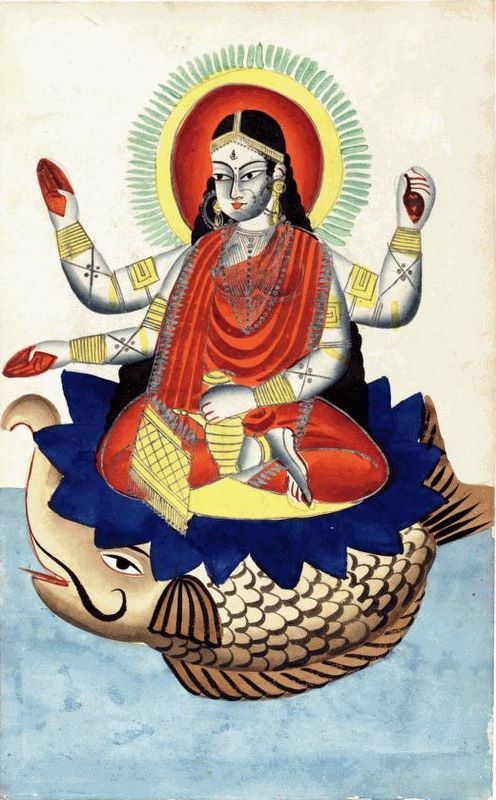

MAYURA
Mayura (Sanskrit: मयूर)
is a Sanskrit word for peacock which is one of the
sacred birds of the Hindu mythology. It is referred to in a number of Hindu
scriptures. It is also a contemporary Hindu name used in many parts of India.
The legend states that the Mayura was created from the feathers of Garuda,
another semi-divine mythical birds of Hindu mythology. Garuda is believed to be
a vahana (conveyance) of Vishnu, one of the Trimurti. In images of the mayura as
a mythical bird, it is depicted as killing a snake, which according to a number
of Hindu scriptures, is a symbol of cycle of time. Many are the gods accompanied
by this sacred bird.

NAGA
Length: (M) 20 Feet , (F) 19'4 Feet
Weight: (M) 400 Pounds , (F) 370 Pounds
Nāga (नाग) is the Sanskrit and Pali word for a deity or class of entity or being, taking the form of a very great snake—specifically the king cobra, found in Indian religions, mainly Hinduism, Buddhism and Jainism. A female nāga is a nāgī or nāgiṇī.
In India, nāgas are considered nature spirits and the protectors of springs, wells and rivers. They bring rain, and thus fertility, but are also thought to bring disasters such as floods and drought.
Nagas are snakes that may take human form. They tend to be very curious. According to traditions nāgas are only malevolent to humans when they have been mistreated. They are susceptible to mankind's disrespectful actions in relation to the environment. They are also associated with waters—rivers, lakes, seas, and wells—and are generally regarded as guardians of treasure.
They are objects of great reverence in some parts of South India, where it is believed that they bring fertility and prosperity to their venerators.
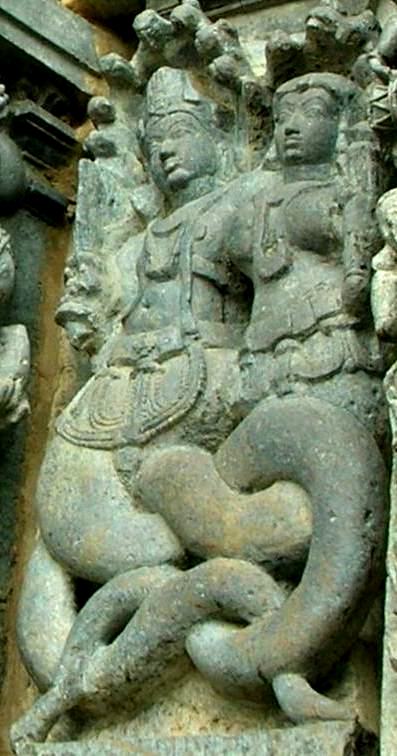
NANDI
Nandi (Sanskrit: नन्दि)
is the name for the bull which serves as the mount (Sanskrit: Vahana) of the god
Shiva and as the gatekeeper of Shiva and Parvati. In Hindu Religion, he is the
chief guru of eighteen masters (18 Siddhar) including Patanjali and Thirumular.
Temples venerating Shiva display stone images of a seated Nandi, generally
facing the main shrine. There are also a number of temples dedicated solely to
Nandi.
The application of the name Nandi to the bull (Sanskrit: vṛṣabha) is in fact a
development of recent centuries, as Gouriswar Bhattacharya has documented in an
illustrated article entitled "Nandin and Vṛṣabha". The name Nandi was earlier
widely used instead for an anthropomorphic deity who was one of Shiva’s two
door-keepers, the other being Mahākāla. The doorways of pre-tenth-century North
Indian temples are frequently flanked by images of Mahākāla and Nandi, and it is
in this role of Shiva’s watchman that Nandi figures in Kālidāsa’s poem the
Kumārasambhava.

NAVAGUNJARA
In the Hindu epic Mahabharata, Navagunjara is a creature composed of nine
different animals. The animal is a common motif in the Pata-Chitra style of
painting, of the Indian state of Odisha. The beast is considered a form of the
Hindu god Vishnu, or of Krishna, who is considered an Avatar (incarnation) of
Vishnu. It is considered a variant of the virat-rupa (Omnipresent or vast) form
of Krishna, that he displays to Arjuna, as mentioned in the Bhagavad Gita, a
part of the epic Mahabharata.
The version of the Mahabharata, written by the Odia poet Sarala Dasa, narrates
the legend of Navagunjara; no other version has the story. Once, when Arjuna was
doing penance on a hill, Krishna-Vishnu appears to him as Navagunjara.
Navagunjara has the head of a rooster, and stands on three feet, those of an
elephant, tiger and deer or horse; the fourth limb is a raised human arm
carrying a lotus or a wheel. The beast has the neck of a peacock, the back or
hump of a bull and the waist of a lion; the tail is a serpent. Initially, Arjuna
was terrified as well as mesmerized by the strange creature and raises his bow
to shoot it. Finally, Arjuna realizes that Navagunjara is a manifestation of
Vishnu and drops his weapons, bowing before Navagunjara.
The Navagunjara-Arjuna scene is sculpted at the northern side of the Jagannath
Temple, Puri. Also, the Nila Chakra disc atop the Jagannath Temple has eight
Navagunjaras carved on the outer circumference, with all facing towards the
flagpost above.
Navagunjara is also depicted in Ganjifa playing cards as the King card and
Arjuna as the minister card, in parts of Orissa, mainly in Puri District and
Ath-Rangi Sara in Ganjam District, Orissa. This set is known as Navagunjara.
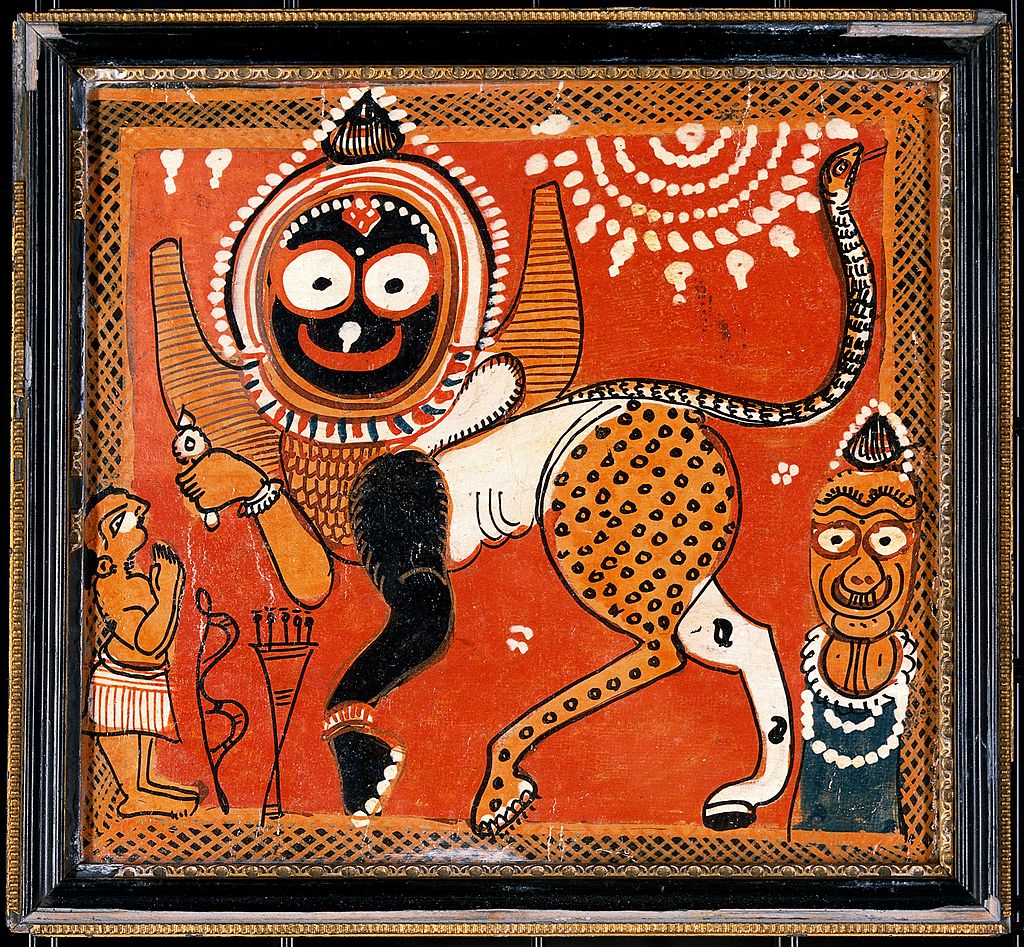
PISHACHA
Height: (M) 9 Feet , (F) 8'4 Feet
Weight: (M) 680 Pounds , (F) 500 Pounds
Pishachas (Sanskrit:
पिशाच, Piśāca) are flesh-eating demons in Hindu
mythology. Their origin is obscure, although some believe that they were created
by Brahma. Another legend describes them as the sons of either Krodha
(figuratively "Anger") or as Dakṣa’s daughter Piśāca. They have been described
to have a dark complexion with bulging veins and protruding, red eyes. They are
believed to have their own languages, known as Paiśāci.
According to one legend, they are sons of Kashyapa and Krodhavasa, one of the
daughters of Prajapati Daksha.The Nilamat Puran of the 7th century mentions the
valley of Kashmir being inhabited by two tribes: the Nagas and the Pisachas.
Piśācas like darkness and traditionally are depicted as haunting cremation
grounds along with other monsters like bhutas and vetālas. Piśācas have the
power to assume different forms at will, and may also become invisible. They
feed on human energies. Sometimes, they possess human beings and alter their
thoughts, and the victims are afflicted with a variety of maladies and
abnormalities like insanity. Certain mantras are supposed to cure such afflicted
persons, and drive away the Piśāca which may be possessing that particular human
being. In order to keep the Piśāca away, they are given their share of offerings
during certain religious functions and festivals.
PRETA
Preta (Sanskrit: प्रेत)
is the Sanskrit name for a type of supernatural being
described in some Indian religions as undergoing suffering greater than that of
humans, particularly an extreme level of hunger and thirst. Preta is often
translated into English as "hungry ghost" from the Chinese adaptation. In early
sources such as the Petavatthu, they are much more varied. The descriptions
below apply mainly in this narrower context.
Pretas are believed to have been false, corrupted, compulsive, deceitful,
jealous or greedy people in a previous life. As a result of their karma, they
are afflicted with an insatiable hunger for a particular substance or object.
Traditionally, this is something repugnant or humiliating, such as cadavers or
feces, though in more recent stories, it can be anything, however bizarre.
The Sanskrit term preta means "departed, deceased, a dead person", from pra-ita,
literally "gone forth, departed". In Classical Sanskrit, the term refers to the
spirit of any dead person, but especially before the obsequial rites are
performed, but also more narrowly to a ghost or evil being. The Sanskrit term
was taken up in Buddhism to describe one of six possible states of rebirth. The
Chinese term egui (餓鬼),
literally "starving ghost", is thus not a literal translation of the Sanskrit
term.
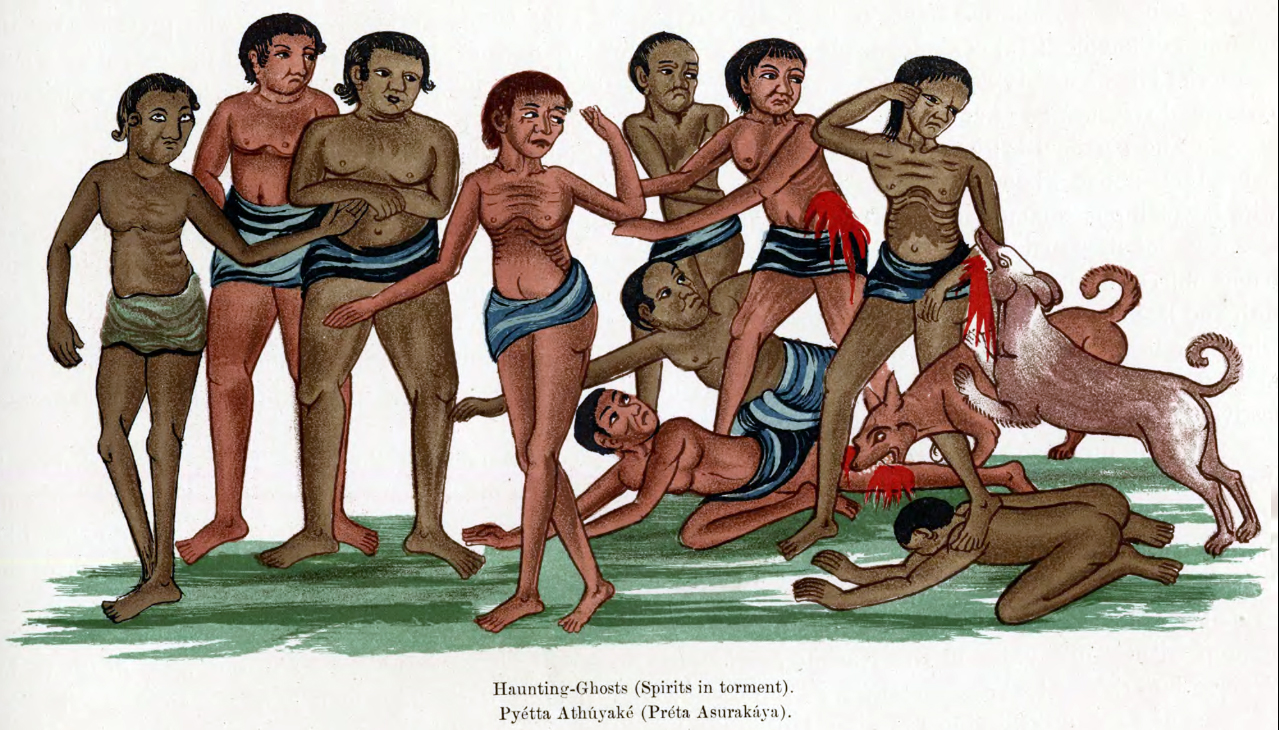
RAKSHASA
Height: (M) 7 Feet , (F) 6'6 Feet
Weight: (M) 280 Pounds , (F) 220 Pounds
A Rakshasa (Sanskrit:
Rākṣasa) is a mythological being in Hindu mythology. As
this mythology influenced other religions, the rakshasa was later incorporated
into Buddhism. Rakshasas are also called 'maneaters" (Nri-chakshas, Kravyads). A
female rakshasa is known as a Rakshasi. A female Rakshasa in human form is a
Manushya-Rakshasi. The terms Asura and Rakshasa are sometimes used
interchangeably.
Rakshasas were most often depicted as ugly, fierce-looking and enormous creatures, with two fangs protruding from the top of the mouth and having sharp, claw-like fingernails. They are shown as being mean, growling like beasts, and as insatiable cannibals that could smell the scent of human flesh. Some of the more ferocious ones were shown with flaming red eyes and hair, drinking blood with their palms or from a human skull (similar to representations of vampires in later Western mythology). Generally, they could fly, vanish, and had Maya (magical powers of illusion), which enabled them to change size at will and assume the form of any creature.

Varaha Avatar killing a Rakshasa
RAINBOW FISH
Length: (M) 16 Feet , (F) 14'9 Feet
Weight: (M) 2000 Pounds , (F) 1790 Pounds
In Hinduism, The Rainbow Fish was a fish that was as large as a whale. It ate Buddha, an incarnation of the deity Vishnu. The Rainbow Fish was caught and killed by some fishermen who freed Buddha from its stomach. After The Rainbow Fish was caught, it provided an entire nation with food for a year.
The scales of the rainbow fish were red, blue, green, and yellow. The green
scales were made of grass, representing the element Earth. The blue scales were
ice, which represented water: the second element. The yellow scales were
lightning, representing air. The red scales were made of fire, representing the
fourth element. The four elements that made up The Rainbow Fish's scales are
also known as Prithvi, Jal, Vayu, and Agni.
ROMPO
Height: (M) 7 Feet , (F) 6'6 Feet
Weight: (M) 150 Pounds , (F) 120 Pounds
Rompo is a mythological beast with the head of a hare, human ears, a
skeleton-like body, the front arms of a badger, and the rear legs of a bear. It
feeds only on human corpses and it is said to croon softly as it eats. Stories
about the Rompo are found in India and Africa. The legend of the Rompo may have
been inspired from sightings of any of the Old world porcupines.
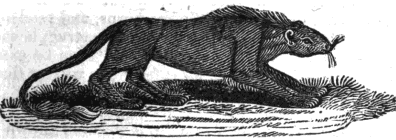
SARAMA
In Hindu mythology, Sarama (Sanskrit:
सरमा,
Saramā; Tamil: Carapai; Thai: Trichada; Malay: Marcu Dewi) is a mythological
being referred to as the female dog of the gods, or Deva-shuni (देव-शुनी,
devaśunī). She first appears in one of Hinduism's earliest texts, the Rig Veda,
in which she helps the god-king Indra to recover divine cows stolen by the Panis,
a class of demons. This legend is alluded to in many later texts, and Sarama is
often associated with Indra. The epic Mahabharata, and some Puranas, also make
brief reference to Sarama.
Early Rig-Vedic works do not depict Sarama as canine, but later Vedic
mythologies and interpretations usually do. She is described as the mother of
all dogs, in particular of the two four-eyed brindle dogs of the god Yama, and
dogs are given the matronymic Sarameya ("offspring of Sarama"). One scripture
further describes Sarama as the mother of all wild animals.
Orientalist Max Müller suggests that the word Sarama may mean "the runner", with
the stem originating from the Sanskrit root sar ("to go"), but he is unable to
account for the second part of the name, ama. Professor Monier-Williams
translates Sarama as "the fleet one". The etymological treatise Nirukta by Yaska
mentions that Sarama derives her name from her quick movement. Mahidhara, a
commentator of the Vajasaneyi Samhita, states that Sarama is "she who entertains
the gods". More broadly, Sarama has also come to mean any female dog.
There are two epithets for Sarama in the original Rig Veda. Firstly, she is
described as supadi, which means "having good feet", "fair-footed" or
"quick", an epithet only used for Sarama in the text. Her other epithet is
subhaga – "the fortunate one", or "the beloved one" – a common epithet of
the Ushas, the Dawn. Sarama's other name Deva-shuni means "divine bitch" or
"bitch of the gods".
It has been suggested that the Greek Hermes is a cognate of Sarama.
SHARABHA
Height: (M) 10 Feet , (F) 9'3 Feet
Shoulder-Height: (M) 6 Feet , (F) 5'6 Feet
Wingspan: (M) 40 Feet , (F) 37 Feet
Weight: (M) 2200 Pounds , (F) 1890 Pounds
In Sanskrit literature, Sharabha is initially described as an animal that roared
and scared other animals in the hills and forest areas. In the later epic
Mahabharata, this form of Sharabha was exaggerated as a lion-slaying monster
with eight legs, eyes on the top; living in the forest and which ate raw flesh.
It is also mentioned as residing on Mount Krauncha but not as a monster but as
an ordinary beast along with lions and tigers on mount Gandhamandana. The epic
also includes Sharabha in the list of edible animals - the mrigajatis- the
animal group of antelope, deer, hare, bear, ruru deer, sambar, gayal, boar, and
buffalo - which was offered as part of food at dinner to guests. Sharabha also
appears as a name of a monkey-king in the epic Ramayana, also as a proper name
of heroes, apes, demons (danavas) and serpent Nāgas and one of the names of god
Vishnu as well as Buddha. In defining the ecological theme in Hindu medicine
related to jungle and the aroma of meats, Sharabha has also been listed among
the deer natives of Kashmir, Nepal, and Sikkim. However, the features explained
are of an eight legged animal of the size of a camel with huge horns and
conjectured as a large Himalayan goat.
Shaiva scriptures narrate that god Shiva assumed the Avatar (incarnation) of Sharabha to pacify Narasimha - the fierce man-lion avatar of Vishnu worshipped by Vaishnava sect. This form is popularly known as Sharabeshwara ("Lord Sharabha") or Sharabeshwaramurti. The Vaishnavas refute the portrayal of Narasimha as being destroyed by Shiva-Sharabha and regard Sharabha as a name of Vishnu. Another tale narrates that Vishnu assumed the form of the ferocious Gandaberunda bird-animal to combat Sharabha. In Buddhism, Sharabha appears in Jataka Tales as a previous birth of the Buddha.
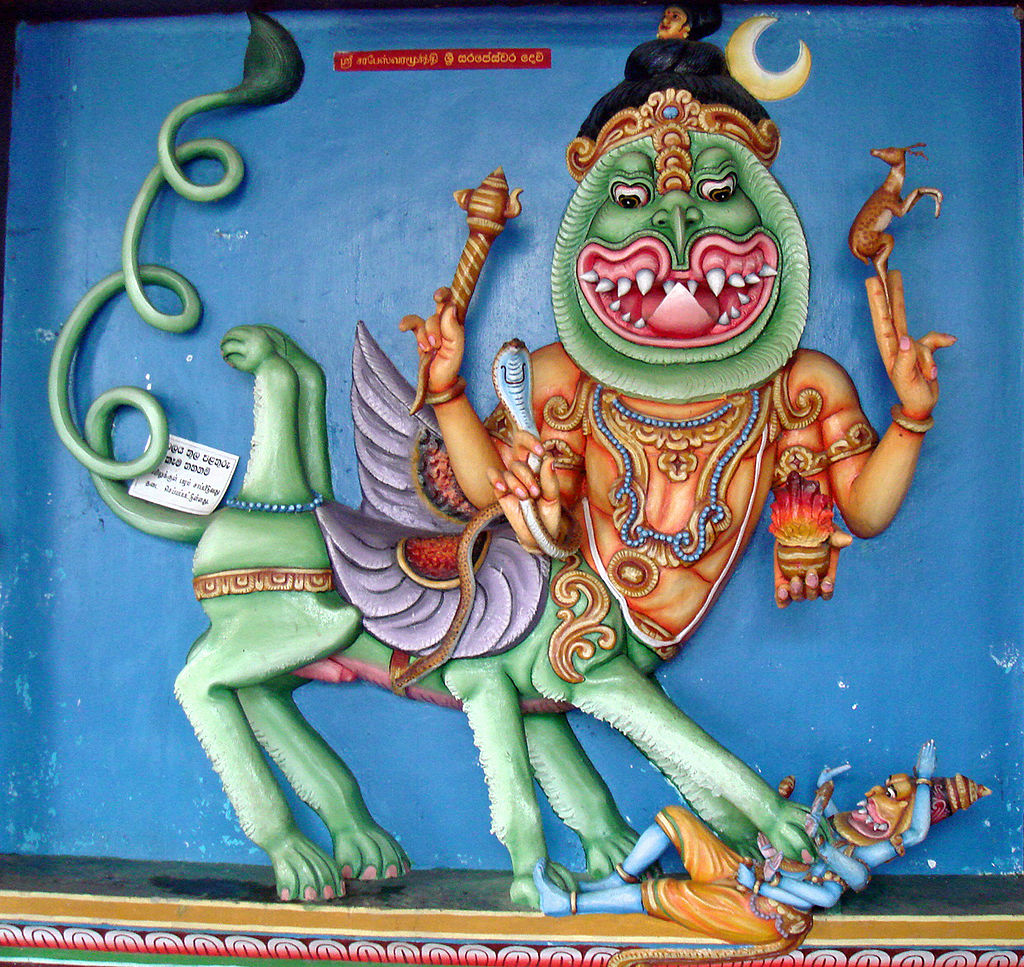
SUPRATIKA
In Hindu mythology there were three elephants by the name Supratika. The
foremost among them is listed as one of the Diggajas, each representing the
eight quarters. The Hindu epic Mahabharata describes two more elephants by the
same name – a mythical elephant that was an incarnation of a sage, and the one
that belonged to Bhagadatta, the king of Pragjyotisha.
The Amarakosha, a thesaurus of Sanskrit, mentions the names of eight male
elephants, that bear the world together, as Airavata, Pundarika, Vamana, Kumunda,
Anjana, Pushpa-danta, Sarva-bhauma, and Supratika. Supratika represents the
north-east direction, the quarter of Soma. Anjanavati is believed to be the wife
of Supratika.

THANACTH
The Thanacth (or Tanacht) is a bizarre cryptid from India, sighted in the 16th
century by European travelers and some locals. They are described as a
tail-less, tiger-like creatures, covered in tawny fur, featuring a human-like
face with long head-hair. It also has a snub nose, is covered in black, frizzly
fur, and has tiger-like back paws, and human-like fore hands. French explorer
André Thevet claimed to have seen it in the sixteenth century.
TIMINGILA
Length: 100 Feet and Weight: 200000 Pounds
“The Gopis have fallen into a great ocean of separation and are being devoured
by the Timingila fish of their ambition to serve You. The Gopis must be
delivered from the mouths of these Timingila, for they are pure devotees. Since
they have no material conception of life, why should they aspire for liberation?
The Gopis do not want that liberation desired by yogis and jnanis, for they are
already liberated from the ocean of material existence." (Cc. Madhya 13.142)
The above verse is quoted from Caitanya-Caritamrta, Madhya-Lila 13.142, wherein
Sri Caitanya Mahaprabhu equates the Gopis as having fallen into a great ocean
and that they are being devoured by their ambition to serve Krsna. Mahaprabhu
compares their ambition to the legendary Timingila fish. The Timingila fish is
said to have lived in the oceans of this planet as the greatest predator ever
known.
The Srimad Bhagavatam, Ramayana, Mahabharata and other Vedic literatures often
speak of fantastic places and of creatures that may have once lived on this
planet. One such creature was the Timingila fish. The Timingila is said to have
been the most formidable predator in the oceans. It was enormous in size and its
favorite food was said to have been whales. Whales are also very big creatures
of the ocean, but unlike the Timingila, the whale has yet to become extinct.
Some whales of our time reach up to 60 feet in length, like the Whale Shark of
the Indian Ocean. The Whale Shark is actually a whale that physically resembles
a shark but is not a predator. The Timingila, on the other hand, was a fierce
predator and used to eat whales in one giant gulp! But did the Timingila
actually exist on this planet or did it exist only in the poetic imagination of
the writers of the Vedic literatures? Certainly many mundane scholars would have
us think so.
Judging by the descriptions, the Timingila could be similar to the Megalodon which was perhaps the most enormous aquatic predator of prehistoric times and lived approximately 15.9 to 2.6 million years ago, during the Cenozoic Era.
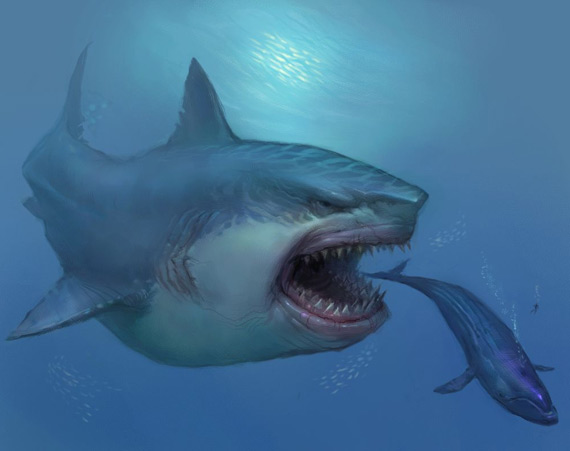
TUMBURU
In Hindu mythology, Tumburu (Sanskrit:
तुम्बुरु),
also spelt Tumbaru (तुम्बरु)
and Tumbara (तुम्बर)
is the best among Gandharvas or celestial musician and
is sometimes described as the best of singers. He is described to perform in the
courts of gods Kubera and Indra as well as sing praises of god Vishnu. He leads
the Gandharvas in their singing.
Tumburu is described the son of sage Kashyapa and his wife Pradha. Among the
sons of Kashayapa, his four Gandharva sons Tumburu, Bahu, Haha and Huhu were
renowned for their sweet and pleasant speech.
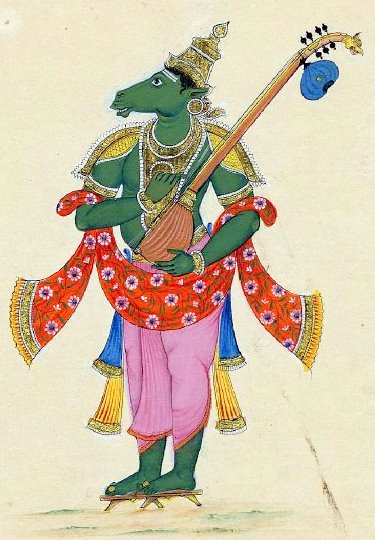
UCHCHAIHSHRAVAS
In Hindu mythology, Uchchaihshravas (Sanskrit:
उच्चैःश्रवस्
Uccaiḥśravas or
उच्चैःश्रवा
Uccaiḥśravā, "long-ears" or "neighing aloud") is a
seven-headed flying horse, created during the churning of the milk ocean. It is
considered the best of horses, archetype and king of horses. Uchchaihshravas is
often described as a vahana ("vehicle") of Indra - the god-king of heaven, but
is also recorded to be the horse of Bali, the king of demons. Uchchaihshravas is
said to be snow white in colour.
The Mahabharata mentions that Uchchaihshravas rose from the Samudra manthan
("churning of the milk ocean") and Indra - the god-king of heaven seized it and
made it his vehicle (vahana). He rose from the ocean along with other treasures
like goddess Lakshmi - the goddess of fortune, taken by god Vishnu as his
consort and the amrita - the elixir of life. The legend of Uchchaihshravas,
rising from the milk ocean also appears in the Vishnu Purana, the Ramayana, the
Matsya Purana, the Vayu Purana etc. While various scriptures give different
lists of treasures (ratnas) those appeared from the churning of the milk ocean,
most of them agree that Uchchaihshravas was one of them.
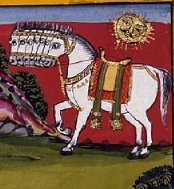
Height: (M) 5 Feet , (F) 4'8 Feet
Weight: (M) 110 Pounds , (F) 90 Pounds
Vānara (Sanskrit: वानर) refers to a group of people living in forests in the Hindu epic the Ramayana and its various versions. In the Ramayana, the Vanaras help Rama defeat Ravana.
The Vanaras are depicted as monkeys in the popular art, their exact identity is not clear. Unlike other exotic creatures such as the rakshasas, the Vanaras do not have a precursor in the Vedic literature. The Ramayana presents them as humans with reference to their speech, clothing, habitations, funerals, consecrations etc. It also describes their monkey-like characteristics such as their leaping, hair, fur and a tail.
According to one theory, the Vanaras are strictly mythological creatures. This is based on their supernatural abilities, as well as descriptions of Brahma commanding other deities to either bear Vanara offspring or incarnate as Vanaras to help Rama in his mission. The Jain re-tellings of Ramayana describe them as a clan of the supernatural beings called the Vidyadharas; the flag of this clan bears monkeys as emblems.
Another theory identifies the Vanaras with the tribal people, who dwelled in the forests and used monkey totems. G. Ramdas, based on Ravana's reference to the Vanaras' tail as an ornament, infers that the "tail" was actually an appendage in the dress worn by the men of the Savara tribe. (The female Vanaras are not described as having a tail.) According to this theory, the non-human characteristics of the Vanaras may be considered artistic imagination. In Sri Lanka, the word "Vanara" has been used to describe the Nittaewos mentioned in the Vedda legends. Nittaewos were said to be a small tribe of small bigfoot or Yeti type hominids native to Sri Lanka.
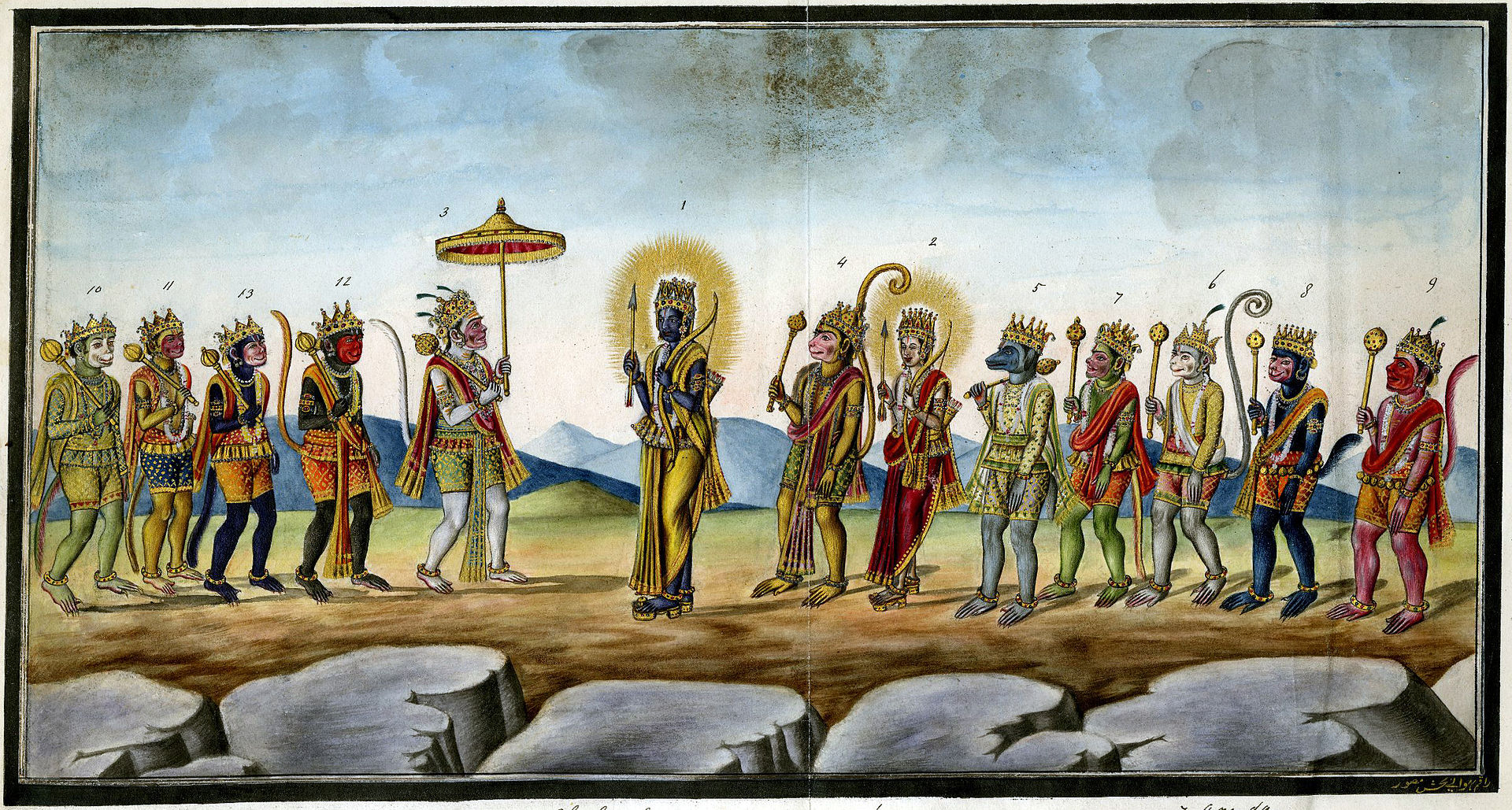
VETALA
The vetala is another vampire of India. The vetala are a class of demons in
Hindu mythology that have the power to enter the bodies of human or animal
corpses and reanimate them. They can enter living victims as well, and
manipulate them as they please. Generally, though, the vetala stick to
inhabiting the bodies of dead people. This myth is also connected with burial
rites or, in some cases, the circumstances of a person’s death. If a body is
buried improperly or does not receive the proper rites, the body is in danger of
becoming possessed by a vetala.
The vetala, also written as vetaal, or baital, use the bodies they inhabit to
wreak havoc in the world. It’s a different concept than a human just becoming a
vampire, after being bitten, or getting infected by one, or being killed by one.
In the lore as we have come to see vampires, they are still the humans they once
were, except with some bloodthirsty tendencies. The vetala are not like that at
all. The vetala demon is a separate entity that takes the body of a human. These
corpses do not have the human’s memories or go after their families and home
villages.
The soul of the person whose corpse the vetala is possessing is completely gone.
The vetala demon simply puts on the body of the person like a shell. Harming or
damaging the corpse that the vetala inhabits does nothing to destroy the vetala.
It simply departs from the corpse, and finds a new one to inhabit.
These are not friendly creatures; they’re one of the most vicious vampires of
Indian lore. They delight in destruction; killing children, causing
miscarriages, and driving people insane.
In some cases, though, the vetala are portrayed in a positive light. The vetala
in the Baital Pachisi, for example, is shown as a heroic character, saving the
life of the protagonist, the king.
There is a series on Disney Channel India called Vicky and Vetaal which is based
on the Baital Pachisi story. It features a young boy named Vicky and his friend
the vampire Vetaal, who drinks milk and not blood. The two have many adventures,
and the Vetaal certainly isn’t portrayed as a malicious demon creature.


Kaalkudaa Vetala
(Bhairavakona cave - Nallamala Hills - Prakasam district - Andhra Pradesh)
YAKSHA
Height: (M) 18 Feet , (F) 16'7 Feet
Weight: (M) 4500 Pounds , (F) 3400 Pounds
Yaksha (Sanskrit यक्ष
yakṣa, Odia-ଯକ୍ଷ,
Pali yakkha) is the name of a broad class of nature-spirits, usually benevolent,
who are caretakers of the natural treasures hidden in the earth and tree roots.
They appear in Hindu, Jain and Buddhist texts. The feminine form of the word is
yakṣī or Yakshini (yakṣiṇī).
In Hindu, Jain, and Buddhist texts, the yakṣa has a dual personality. On the one
hand, a yakṣa may be an inoffensive nature-fairy, associated with woods and
mountains; but there is also a darker version of the yakṣa, which is a kind of
ghost (bhuta) that haunts the wilderness and waylays and devours travelers,
similar to the rakṣasas.
In Kālidāsa's poem Meghadūta, for instance, the yakṣa narrator is a romantic
figure, pining with love for his missing beloved. By contrast, in the didactic
Hindu dialogue of the Yakṣapraśnāḥ "Questions of the Yakṣa", it is a tutelary
spirit of a lake that challenges Yudhiṣṭhira. The yakṣas may have originally
been the tutelary gods of forests and villages, and were later viewed as the
steward deities of the earth and the wealth buried beneath.
In Indian art, male yakṣas are portrayed either as fearsome warriors or as
portly, stout and dwarf-like. Female yakṣas, known as yakṣiṇīs, are portrayed as
beautiful young women with happy round faces and full breasts and hips.

Read More: The Questions of Yaksha
YAKSHINI
Yakshini (Sanskrit:
याक्षिणि, also known as Yakshi and Yakkhini in Pali)
are mythical beings of Hindu, Buddhist, and Jain mythology. Yakshini (Yakshi) is
the female counterpart of the male Yaksha, and they are attendees of Kubera, the
Hindu god of wealth who rules in the mythical Himalayan kingdom of Alaka. They
are the guardians of the treasure hidden in the earth and resemble fairies.
Yakshinis are often depicted as beautiful and voluptuous, with wide hips, narrow
waists, broad shoulders, and exaggerated, spherical breasts. In Uddamareshvara
Tantra, thirty-six Yakshinis are described, including their mantras and ritual
prescriptions. A similar list of Yakshas and Yakshinis are given in the
Tantraraja Tantra, where it says that these beings are givers of whatever is
desired. Although Yakshinis are usually benevolent, there are also yakshinis
with malevolent characteristics in Indian folklore.
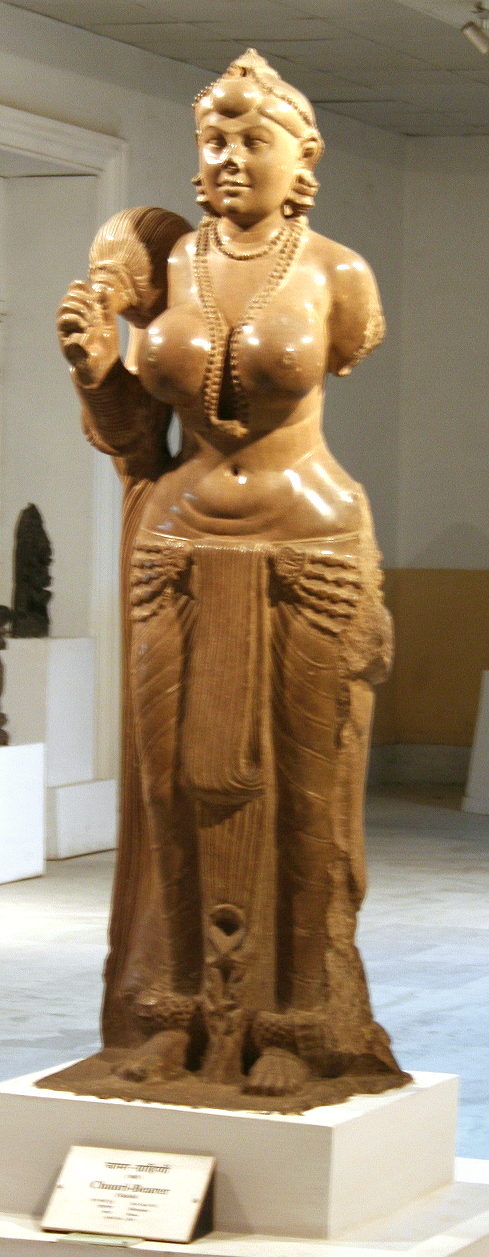
YALI
Shoulder-Height: (M) 5 Feet , (F) 4'7 Feet
Length: (M) 9'3 Feet , (F) 8'5 Feet
Weight: (M) 1300 Pounds , (F) 1050 Pounds
Indian Elephant-Headed + Asiatic Lion = Yali
Yali (also known as Vyala or Vidala in Sanskrit) is a mythical creature seen in many Hindu temples, often sculpted onto the pillars. It may be portrayed as part lion, part elephant and part horse, and in similar shapes. Also, it has been sometimes described as a leogryph (part lion and part griffin), with some bird-like features.
Yali is a motif in Indian art and it has been widely used in south Indian sculpture. Descriptions of and references to yalis are very old, but they became prominent in south Indian sculpture in the 16th century. Yalis are believed to be more powerful than the lion/Tiger or the elephant.

